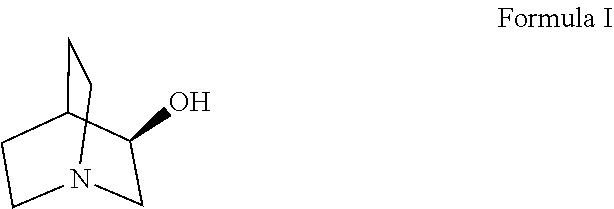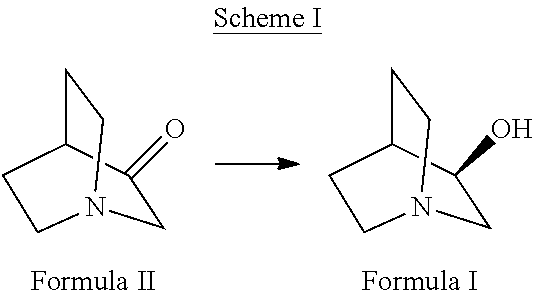Highly efficient enzymatic process to produce (r)-3-quinuclidinol
a high-efficiency, enzymatic technology, applied in the direction of oxidoreductases, organic chemistry, fermentation, etc., can solve the problems of lack of reproducibility, time-consuming, tediousness of quinuclidinol, etc., to increase the substrate loading and reduce the reaction time of enzymatic conversion
- Summary
- Abstract
- Description
- Claims
- Application Information
AI Technical Summary
Benefits of technology
Problems solved by technology
Method used
Image
Examples
example 1
n of (R)-3-quinuclidinol Using Whole Cells
[0069]For the bioconversion of 1 g of 3-quinuclidinone, 4 g of cell mass was used in a reaction mix comprising 10 mg of NADP, 6 g of glucose, 10 mg of glucose dehydrogenase in a final volume of 40 ml. Reaction mass was mixed at 150 rpm on a rotary shaker at 25° C.±1° C. for 3-4 h. pH was adjusted intermittently to ˜6.5-7.5 using 20% NaOH solution. The reaction was monitored for the completion by silica gel-Thin Layer Chromatography (TLC).
example 2
n of (R)-3-quinuclidinol Using Cell Lysate
[0070]The reaction mixture comprised of 100 ml cell lysate containing at least 4 units of ketoreductase per millilitre and 50 ml cell lysate containing not less than 250 units of glucose dehydrogenase enzyme per millilitre along with 30 mg of NADP and 1.4 g of glucose, 10 g 3-quinuclidinone. The final volume of the reaction mixture was 150 ml. Reaction mass was stirred at 150 rpm on a rotary shaker at 25° C.±1° C. for 3-4 h. pH was constantly adjusted to ˜6.8-7.5—using 20% NaOH. At 4 h, the mixture was sampled to analyze conversion of the substrate 3-quinuclidinone and determine the enantiomeric purity of the product (R)-3-quinuclidinol.
example 3
n of (R)-3-quinuclidinol Using Cell Lysate with Increased Substrate Loading in the Reaction
[0071]Reaction mass comprising of ˜60 mL of cell lysate containing at least 4 units of ketoreductase enzyme per milliliter, ˜30 mL cell lysate containing not less than 250 units of glucose dehydrogenase enzyme per millilitre and 30 mg of NADP was used. 3-quinuclidinone was varied from 10.0 g, 12.5 g, 15.0 g, 17.5 g and 20.0 g in a final reaction volume of ˜100 mL. Reaction mass was stirred at 150 rpm on a rotary shaker at 25° C.±1° C. for 3-10 h. pH was constantly adjusted to ˜6.8-7.5 using 20% NaOH. After 10 h the mixture was sampled and analyzed the conversion of 3-quinuclidinone by TLC. Complete conversion was observed in all reactions.
PUM
 Login to View More
Login to View More Abstract
Description
Claims
Application Information
 Login to View More
Login to View More - R&D
- Intellectual Property
- Life Sciences
- Materials
- Tech Scout
- Unparalleled Data Quality
- Higher Quality Content
- 60% Fewer Hallucinations
Browse by: Latest US Patents, China's latest patents, Technical Efficacy Thesaurus, Application Domain, Technology Topic, Popular Technical Reports.
© 2025 PatSnap. All rights reserved.Legal|Privacy policy|Modern Slavery Act Transparency Statement|Sitemap|About US| Contact US: help@patsnap.com



